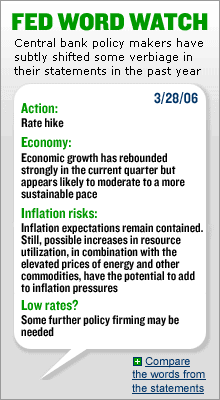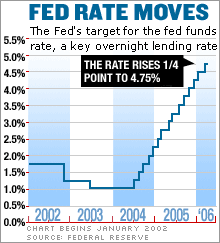Decoding the Fed's confusing message
Another rate hike is all but certain. What happens next is unclear, to the markets and maybe even to the Fed itself.
NEW YORK (CNNMoney.com) - Interest rates are set to rise. That much we know. Federal Reserve policy-makers are meeting Wednesday and there's little question about what they'll do.
According to rate futures on the Chicago Board of Trade, investors are betting another quarter-point hike in the fed funds rate is a sure thing. That would take the Fed's overnight rate target to 5 percent, and be the 16th straight increase since the central bank began raising rates in June 2004. Beyond that, it gets a little foggy. In recent weeks, Fed Chairman Ben Bernanke told Congress the central bank may pause in the near future. But when? Will it be in June, as financial markets seem to be expecting, or not until August? Then again, maybe the Fed isn't going to pause so soon after all. Bernanke told the Joint Economic Committee that the Fed might pause soon to assess the impact of nearly two years of rate increases on the world's largest economy. In his testimony, he said the economy was strong but would probably slow soon, perhaps this quarter, and that a pause could come even if core inflation should pick up, since it's a lagging indicator. But more recently, Bernanke reportedly made comments to CNBC anchor Maria Bartiromo about how the markets got his message wrong and that he should not be viewed as being dovish about inflation. When Bartiromo reported this last week, stocks fell and bonds extended their losses. Looking for clarity
This all puts a lot of pressure on the Fed to give the markets some clarity, especially in the statement that follows today's decision. "Investors are always keenly focused on the language and the message the Fed is trying to communicate," said Wan-Chong Kung, senior bond portfolio manager at First American Funds. "But with the confusion around Bernanke's statement to Congress, and subsequent back-tracking, there may a greater focus than usual." In particular, investors will be looking to see if there is a change in the statement from the March meeting, in which the central bank said "some further policy firming may be needed to keep the risks to the attainment of both sustainable economic growth and price stability roughly in balance." Translation: More rate hikes may be needed to keep inflation in check Brian Carlin, head of bond trading at JP Morgan Private Bank, said that if the Fed wants to signal a pause in June, it will remove that sentence. But with oil prices near $70 a barrel, he doesn't see a pause just yet since high energy prices could for prices of consumer goods higher. Timothy Ghriskey, chief investment officer at Solaris Asset Management, also thinks the statement will probably show little change since March. And even if the Fed does hint at a possible pause, investors should realize that a pause doesn't necessarily mean the Fed is through raising rates this year, he added. "We may see (another) tipping of the hat that we are in the later stages of the (rate-hiking) cycle, and that any eventual pause will be a hiatus, not a ceasing," he said. A pause in June?
Making the Fed's job tougher is that future rate hikes may wind up hurting the economy. First American's Kung notes that if the Fed raises rates a quarter point next week, that would mean the fed funds rate has jumped 4 percentage points over nearly two years. The Fed's job is "much harder now than when the Fed funds rate was at 1 or 2 percent," Kung said. With that in mind, some say the Fed should pause to gauge the impact of higher rates. That would show the financial markets that the Fed is sensitive about not raising rates so far as to stall economic growth. If the Fed finds it's gone too far and then has to start cutting rates again, as they have not that long ago, that could unnerve investors. "The history of monetary policy shows that toward the end of a cycle, the Fed panics and over-tightens," said Michael Strauss, chief economist at Commonfund. "We saw that under both Alan Greenspan and (his predecessor) Paul Volcker, and Bernanke may be wary of that." Meanwhile, some of the Fed's work has been done by the recent run up in the yield on 10-year Treasury notes, which have jumped from 4.5 percent to 5.15 percent since Bernanke took the helm at the Fed, said JP Morgan's Carlin. Long-term bond rates have a direct impact on mortgage rates, and rising mortgage rates are already cooling real estate, which has been a key driver of economic growth in recent years. "That's going to put some natural brakes on the economy," Carlin said, referring to the rise in bond yields. "It gives the Fed more flexibility. At least Bernanke doesn't have Greenspan's 'conundrum,' since long-term yields are rising along with short-term yields." The problem is that recent reports have shown that the economy remains robust, which means the Fed could need to keep raising. Still, Kung says the Fed will take a break in June and can resume tightening if the economy shows unexpected strength in the second half. "I take what Bernanke says at face value," Kung said. "I think the Fed will pause after the May meeting, but reserve the right to come back." That view seems popular with investors. Futures contracts are pricing in just a 30 percent chance of another rate hike at the Fed's June 28-29 meeting. ---------------------------------- What Bernanke told Congress. Click here. Honeymoon over for Fed chief. More here.
End to rate hikes may end stock rally. Click here. |
| ||||||||||||||




